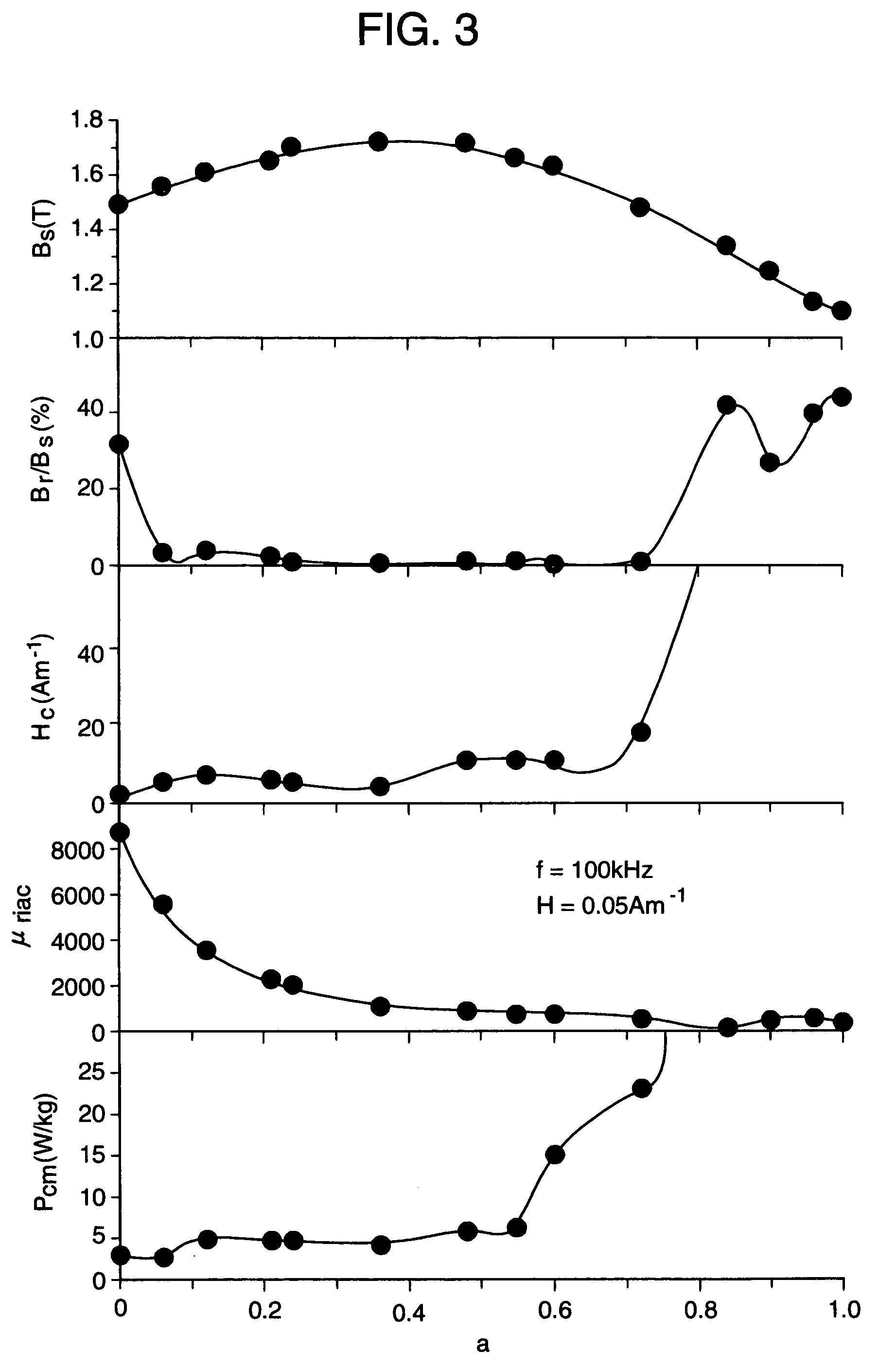Low core loss magnetic alloy with high saturation magnetic flux density and magnetic parts made of same
a magnetic alloy and low core loss technology, applied in the direction of magnetic materials, magnetic bodies, inductance/transformer/magnet manufacture, etc., can solve the problems of low saturation magnetic flux density of ferrite materials, poor temperature characteristics, large core losses, etc., to achieve low core loss, high saturation magnetic flux density, the effect of easy production
- Summary
- Abstract
- Description
- Claims
- Application Information
AI Technical Summary
Benefits of technology
Problems solved by technology
Method used
Image
Examples
example 1
[0032]A molten alloy having a composition represented by the general formula:
(Fel-aCoa)bal.Cu0.7Nb6.8Si0.4B9.2(atomic %)
was rapidly quenched by a single roll method to produce an amorphous alloy ribbon of 5 mm in width and 18 μm in thickness. Next, this amorphous alloy ribbon was wound into dimensions of 19 mm in outer diameter and 15 mm in inner diameter to produce a toroidal core.
[0033]Thus produced magnetic core is inserted into a heat treatment furnace in a nitrogen gas atmosphere, and is subjected to a heat treatment with a pattern of the heat treatment shown in FIG. 1. During the heat treatment, a magnetic field of 280 kAm−1 is applied in a direction perpendicular (width direction of alloy ribbon) to a magnetic path of an alloy core, that is, in a height direction of the core. An alloy after the heat treatment is crystallized, and as a result of an observation by an electron microscope it is found that most of the alloy structures were occupied by fine crystal grains of body c...
example 2
[0035]A molten alloy having compositions shown in table 1 was rapidly quenched by a single roll method in an Ar gas atmosphere to produce an amorphous alloy ribbon of 5 mm in width and 18 μm in thickness. This amorphous alloy ribbon was wound into dimensions of 19 mm in outer diameter and 15 mm in inner diameter to produce a toroidal core. This alloy core is subjected to a heat treatment with a pattern of the heat treatment similar to that in the example 1 to make measurement with respect to its magnetism. Within an alloy structure after the heat treatment, ultrafine crystal grains with grain size of not larger than 50 nm are formed in a parent amorphous phase. Main crystal phases are body centered cubic (bcc) phases containing mainly Fe and Co and when containing Cu or Au, although X-ray analyses of them is not clear and they are not listed in a table, it was confirmed as a result of electron beam diffraction by the use of an electron microscope that face centered cubic (fcc) phase...
example 3
[0037]A molten alloy 150 g having a composition shown in a table 2 was rapidly quenched by a single roll method in an Ar gas atmosphere to produce an amorphous alloy ribbon of 5 mm in width and 18 μm in thickness. As nozzles, quartz nozzles are used. The amorphous alloy ribbons are repeatedly produced by using the used nozzle, and the number of usable times of the nozzle until production of the ribbons having specified widths becomes difficult are studied. Obtained results are shown in the table 2. Furthermore, this amorphous alloy ribbon is wound into dimensions of 19 mm in outer diameter and 15 mm in inner diameter to produce a toroidal core. This alloy core is subjected to a heat treatment with a pattern of the heat treatment similar to that in the example 1 to make measurement with respect to its magnetism. Within an alloy structure after the heat treatment, ultrafine crystal grains with grain size of not larger than 50 nm are formed. Main crystal phases are body centered cubic ...
PUM
| Property | Measurement | Unit |
|---|---|---|
| grain size | aaaaa | aaaaa |
| saturation magnetic flux density Bs | aaaaa | aaaaa |
| saturation magnetic flux density | aaaaa | aaaaa |
Abstract
Description
Claims
Application Information
 Login to View More
Login to View More - R&D
- Intellectual Property
- Life Sciences
- Materials
- Tech Scout
- Unparalleled Data Quality
- Higher Quality Content
- 60% Fewer Hallucinations
Browse by: Latest US Patents, China's latest patents, Technical Efficacy Thesaurus, Application Domain, Technology Topic, Popular Technical Reports.
© 2025 PatSnap. All rights reserved.Legal|Privacy policy|Modern Slavery Act Transparency Statement|Sitemap|About US| Contact US: help@patsnap.com



